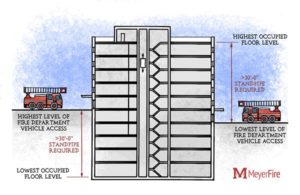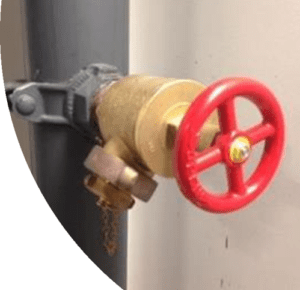What? Another Automatic Sprinkler Trade-Up!
There are many design advantages to installing automatic fire sprinkler in a building, but did you know that the International Building Code (IBC) allows class I standpipes as an alternative to class III standpipes in buildings protected by automatic fire sprinklers?
One must understand that class I standpipes are designed and utilized by the fire service to extinguish fire. Class II standpipes are designed and utilized by trained fire brigades and building occupants to contain fire. And finally, Class III standpipes are simply a class I and a class II standpipe in the same location.
The requirement for standpipes, in this scenario, is height, which in turn triggers the requirement of a class III standpipe. The 2018 IBC Section 905.3.1 -Height, requires class III standpipes to be installed in buildings where the floor level of the highest story is located more than 30 feet above the lowest level of fire department vehicle access or 30 feet below the highest level of fire department vehicle access.

Once they are required, the IBC has several exceptions, one of which is a class I standpipe in leu of the class III. The exception simply states that class I standpipes are allow in buildings equipped with an automatic sprinkler system. This allows for the deletion of the class II portion, 1 ½ in. hose connection, hose/nozzle and potentially a cabinet, of the class III. What remains is the class I standpipe used by training fire department for structural firefighting.
NFPA 14 Standard for the Installation of Standpipe and Hose Systems does however require the installation of a 2 ½ in. x 1 ½ in. reducer, cap, and chain to be installed in this installation and approval of the Authority Having Jurisdiction (AHJ).

The benefit is seen throughout the life of the systems from the initial design, installation and all the way through the inspection, testing and maintenance of the system. Most of these are simply cost benefits, but there are others that should be the driving force in the use of this exception. First, the lack of occupant or fire brigades trained to use the class II portion of the system to contain a fire. In modern societies, we have just pivoted away from the concept of occupant trained fire bridges. Secondly and probably the most important reason is emergency egress. Without proper training, the occupants of the buildings should simply be encouraged to egress the building in the event of a fire or emergency, unless given other direction by the fire department.
Using these sprinkler tradeoffs is a major advantage in the design phase. Tradeoffs can provide a major cost savings in the overall construction of a project and throughout the life of the system. Especially when you compile them with many additional sprinkler tradeoffs which can be found in the, “NFSA Sprinkler Guide: 2018 International Building Code Edition.” We will continue discussing these tradeoffs in detail in future blogs.
